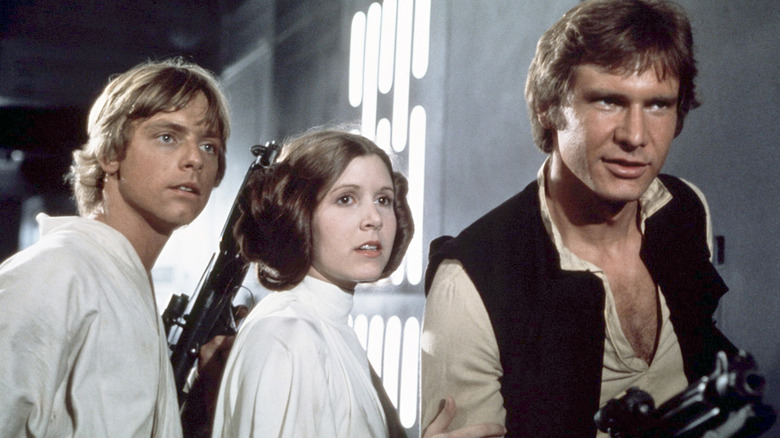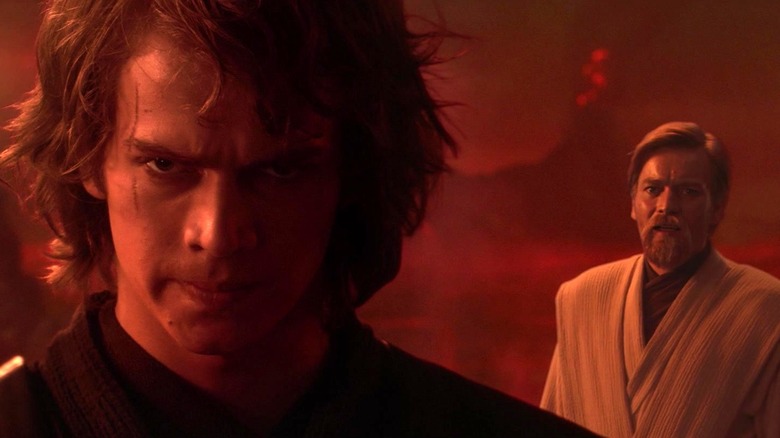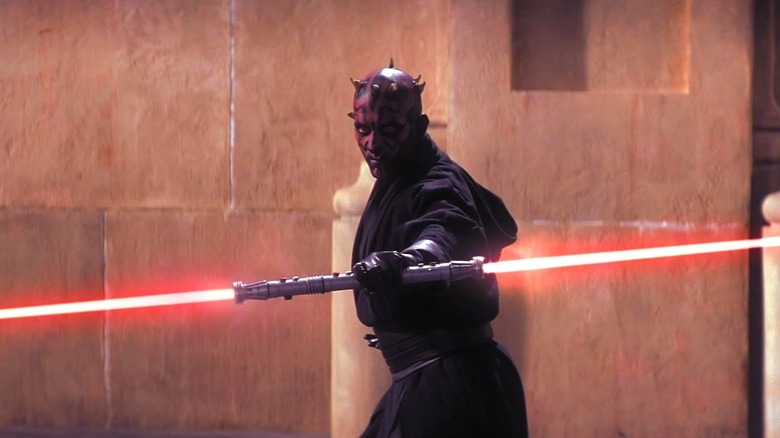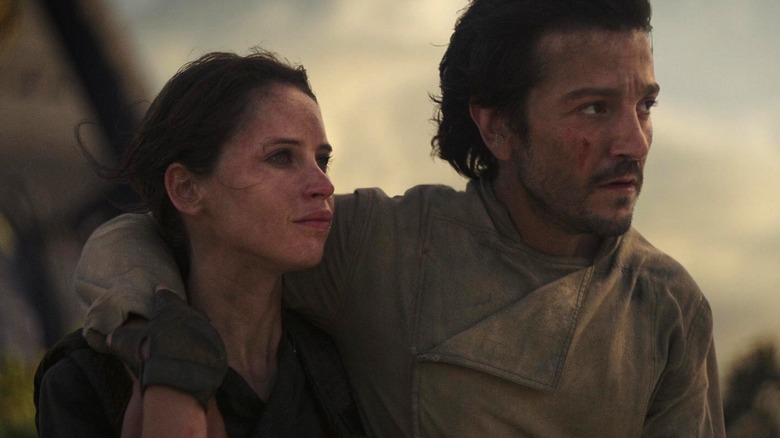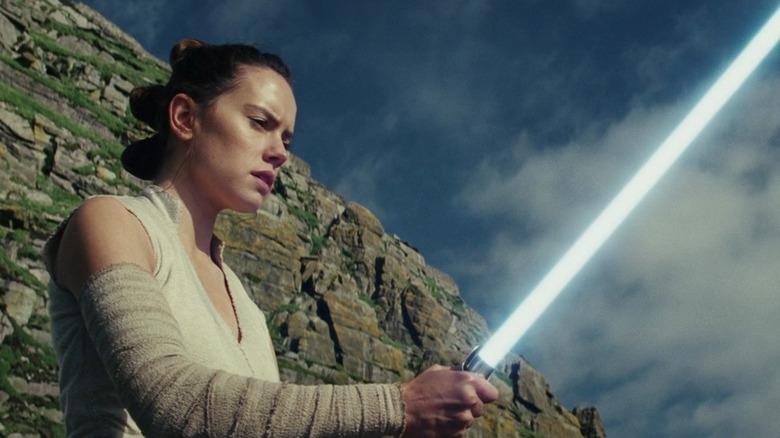The Star Wars Machete Order Flips The Saga On Its Head — For The Better
We may receive a commission on purchases made from links.
There's never a bad time to revisit our beloved galaxy far, far away. Maybe you're a serial rewatcher like me, who personally does a refresh of the entire "Star Wars" saga every year and is always looking for ways to switch it up. Or perhaps you have a loved one who's interested in immersing themselves into "Star Wars" with you for the very first time, and you're having a dilemma on whether you should introduce them to Luke or Anakin Skywalker first. There's the tried and true path every lifelong fan knows with the release order, but creator George Lucas argues that the only intended way to watch the franchise is in chronological order.
In the years since Lucasfilm revived the franchise under the Disney banner, there are now five more theatrical "Star Wars" films to account for, including canon spin-offs outside of the main Skywalker timeline such as "Rogue One" and "Solo: A Star Wars Story." Where do these all fit into the equation? If you're looking for a fresh, thematically interesting, and accessible way to experience the Skywalker Saga, consider the "Machete Order," which was first coined by blogger Rod Hilton. But what exactly is the Machete Order?
Well, many fans who grew up with the original trilogy and watched the prequel trilogy in theaters would eventually become parents themselves, wondering how exactly they should pass their fandom on to their children. This is where the Machete Order comes in. Conceived in November 2011, Hilton specifically designed it for viewers with no prior knowledge of "Star Wars" to have the best possible narrative and thematic experience of George Lucas' sprawling, space pic.
There are problems watching Star Wars in chronological and release order
Of course, you might ask, why does anyone need the Machete Order in the first place? Well, as first watches, there are some major issues that arise with the two most accepted viewing orders — chronological and release date. Respectfully, we have to disagree with George Lucas here about watching the saga in chronological order. By digging into the prequels first, you'll end up spoiling the big twist of "The Empire Strikes Back" for your potential convert (and there are many fans that can only dream of experiencing that plot twist blind for the first time).
While Anakin is a great character, he's much more compelling as a foil to Luke and his struggle with the light versus dark, rather than the hero of his own trilogy. And though the prequels have gotten their rightful re-evaluation in recent years, they're still extremely heavy on exposition, world-building, and large information dumps that could scare away first-timers.
As for watching it by release order, "A New Hope" is the best introduction to the "Star Wars" universe there is, balancing the right amount of lore, adventure, and loveable characters to view the rest of the saga with. So this has to be the best way to go, right? Unfortunately, since the most accessible versions of the original trilogy are Lucas' special editions (which have been modified to include tie-ins with the prequels), problems arise from watching in release order.
In one of the final scenes of "Return of the Jedi," Hayden Christensen's Anakin was added as a Force ghost that watches over Luke in the Ewok Village, replacing Sebastian Shaw. If you're watching for the first time, there's no way one would know that the young man standing beside Obi-Wan and Yoda is Luke's father, allowing the emotional weight of the scene to fall completely flat.
Why the Star Wars Machete Order is the best viewing experience
This brings us back to the proposed 2011 Machete Order, which is "IV," "V," "II," "III," "VI." The idea here is that after you experience the parentage plot twist and the exciting cliffhanger at the end of "Empire," you'll jump to the prequels and watch them as if they are one big flashback, exploring Anakin's descent into the dark side and tying it back to Luke's own hero's journey as you transition back into "Return." It not only retroactively fixes all of the issues with the previous watch methods, but it also adds so much more depth and drama to both trilogies. You can tangibly feel the time skip between "Empire" and "Return." The Order 66 scenes in "Revenge of the Sith" now feel a lot less dour and hopeless as Luke breaks the cycle of violence, and the generational, political allegory of "Star Wars" feels a lot more coherent.
However, since this watch order was developed in 2011, there are a few notable flaws with the original Machete Order. You might have noticed here that "The Phantom Menace" is excluded from this list, as Hilton argued that the events of the first prequel film are largely irrelevant to the rest of the saga.
As much as it is irritating to sit through Jar-Jar Binks, Watto, and the elongated pod-race scene, I disagree with Hilton's decision to scrap "Phantom." It's extremely thematically important that we see the origins of little Anakin and Obi-Wan's relationship. Darth Maul isn't just a cool villain to look at, his defeat of Qui-Gon Jinn is what sets the entire story of "Star Wars" in motion — as Dave Filoni once explained, the fate of the galaxy was decided in this battle between Jedi and Sith.
Do the Star Wars sequels and spin-offs fit in the Machete Order?
As we continue to update the Machete Order, we'll need to address what to do with the Disney-Lucasfilm era, which includes the controversial sequel trilogy, as well as spin-offs and Disney+ series.
Like it or not, the sequel era is canonically part of the Skywalker Saga and therefore has its place in the Machete Order. Luckily, it's very easy to tack on the last trilogy right after "Return of the Jedi." While "The Force Awakens" echoes "A New Hope" and was designed to be a modern starting point for newcomers to the series, I believe it is still best appreciated with a previous investment in Luke, Han, and Leia, who all play wonderful supporting roles this time around.
As far as the spin-offs and various Disney+ series are concerned, we'll consider all of it supplemental material and leave it out of the Machete Order, as they're probably best appreciated as their own projects separate from the Skywalker Saga. As much as "Rogue One" makes a seamless transition into the opening moments of "A New Hope," it probably shouldn't be a convert's introduction to "Star Wars." The same goes for "Solo," "Obi-Wan Kenobi," "The Mandalorian," "Andor," "The Acolyte," "Ahsoka," and "Skeleton Crew," which pull from knowledge of all eras of the timeline.
Our version of the Machete Order is designed for Star Wars newcomers and diehard fans
With that, we have our own final updated Machete Order:
-
"Episode IV: A New Hope"
-
"Episode V: The Empire Strikes Back"
-
"Episode I: The Phantom Menace
-
"Episode II: Attack of the Clones"
-
"Episode III: Revenge of the Sith"
-
"Episode VI: Return of the Jedi"
-
"Episode VII: The Force Awakens"
-
"Episode VIII: The Last Jedi"
-
"Episode IX: The Rise of Skywalker"
It's far from the obvious way to approach this franchise, but watching the "Star Wars" saga out of order actually proves to be one of the most narratively and thematically satisfying ways to enjoy the films to date. It's not only an optimal way for first time viewers to experience the Skywalker Saga, it might also give long-time fans a new perspective on the prequel/sequel eras, the cycle of generational trauma, and the endless struggle between light and dark that is the core of Lucas's epic story.
All "Star Wars" movies are now streaming on Disney+.
